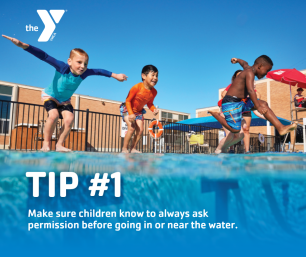Water Safety Should Be Top Of Mind
Date: May 1, 2024

The Central Connecticut Coast YMCA is offering tips for parents to keep kids safe in and around water this summer.
The Central Connecticut Coast YMCA wants to ensure that water safety doesn’t get lost in our community’s eagerness to jump into the water. As temperatures rise, kids want to cool off, whether that is in home pools, oceans, ponds, lakes, rivers, or streams. And that means the risk of drowning is as prevalent as ever. The Central Connecticut Coast YMCA is encouraging parents and caregivers to reinforce the importance of water safety skills with the whole family.
“As ‘America’s Swim Instructor,’ the Central Connecticut Coast YMCA annually teaches more than 9,850 children valuable water safety and swimming skills,” said Tim Bartlett, CCCY President & CEO. “Now more than ever, it’s important to remind parents and caregivers that water safety needs to be top-of-mind as families participate in one of their favorite summertime activities.”
The Y is encouraging parents to play an active role in promoting water safety and provides six tips to ensure a safe and enjoyable swimming experience for all.
- Make sure children know to always ask permission before going in or near the water. Teaching your children to be water smart is the first step in water safety – be sure they understand the importance of asking permission before going in or near the water.
- Never swim alone or without a water watcher. When children are swimming, make sure they are actively supervised at all times. Teach your children that they should only swim in locations where a lifeguard is on duty, or where a responsible adult agrees to watch the children in the water without distractions.
- Supervise your children whenever they’re in or near water. Whether it’s bath time or taking a dip in a pool or waterfront, make sure your children are within arm’s reach at all times.
- Don’t engage in breath holding activities. Children should not hold their breath for a prolonged amount of time while swimming, as this can be dangerous.
- Wear a life jacket. Inexperienced or non-swimmers should wear a Coast Guard-approved life jacket.
- Don’t jump in the water to save a friend who is struggling in deep water. If a child finds their friend in deep water unexpectedly, their natural reaction may be to jump in the water to try to save them. Even if a child is a great swimmer, a panicked person will overpower them, pulling the rescuer underwater. The Y’s Safety Around Water program teaches the “reach, throw, don’t go” concept of using a long object to reach for them and pull them to safety. By using this technique children can help their friend without compromising their own safety.
To learn more about the Y’s swim programs, please continue to browse our web site – swim lessons are shared under SWIM and also in our Program Guides.
Be Safe!
